Recap: TIIDELAB AI Pre-fellowship Experience
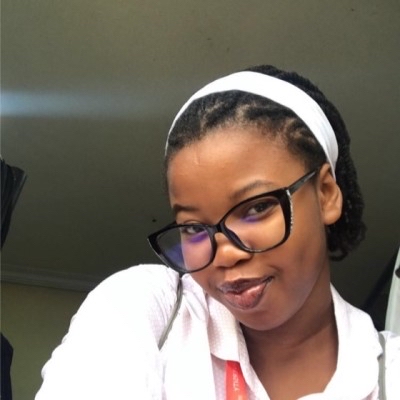 Zion Ukpong
Zion Ukpong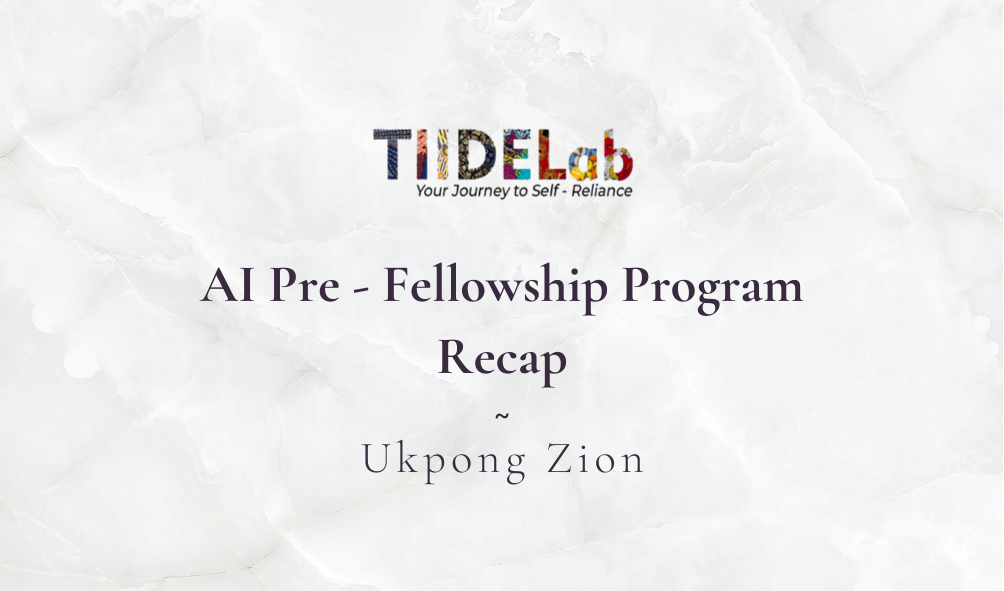
Dearest gentle reader,
I welcome you to my tech-focused late June & July recap. During this time, I was enrolled in the TIIDELAB AI Pre-fellowship program. I will be sharing my experience in this article and I intend to keep it concise, interesting and insightful. Grab your shoes, tighten your ropes, and walk with me...
Prologue
This tale begins on June 19th when I got an invitation to the onboarding session taking place on June 20th from TIIDELAB. This session was mandatory so it was important that intending participants of the program attended.
Upon participation, we got introduced to TIIDELAB, their operations and how the pre-fellowship was going to look, and it got interesting from there.
Week One: 20 - 26 June
In the first week, we learned how to install and set up the required coding environments for building projects. This includes Git & GitHub, Visual Studio Code, a web browser and Hashnode for documentation. Next, we got acquainted with HTML. Although I had prior knowledge, it was a nice refresher. We learned the syntax of writing HTML code, and about HTML tags, elements and attributes.
Our learning took a project-based approach facilitated by the codewithunclebigbay.com learning platform. At the end of the first week, we built the HTML structure of the landing page of a Barber Shop.
We were also given the task of finding accountability partners. I found one, and we've been partners from the very start of this program, even until now as we draw the curtains to close the program.
The accountability partner's job was crucial yet simple: make sure your partner attends classes, submits assignments and is punctual. My partner, Kehinde, understood the assignment.
At the end of the week, we held our first town hall session where we discussed various topics and elected our first class governor and assistant. This session was led by the coordinator, Mr. Aderoju Shamsudeen. The town hall sessions took place weekly.
Week Two: 27 June - 4 July
We were introduced to CSS and its fundamental concepts in the second week. We learned how to apply CSS styling to HTML elements, different ways to link CSS to an HTML file and the basics of CSS selectors, properties and values. To practice, we applied all we learned by styling the Barber Shop landing page.
By the end of the second week, we were grouped and assigned to different teams. I was in Team 6; we gave ourselves the nickname T-Quest and conducted an election to choose a Team Lead. Oronsaye Destiny was elected the team lead, and I volunteered to be the assistant team lead.
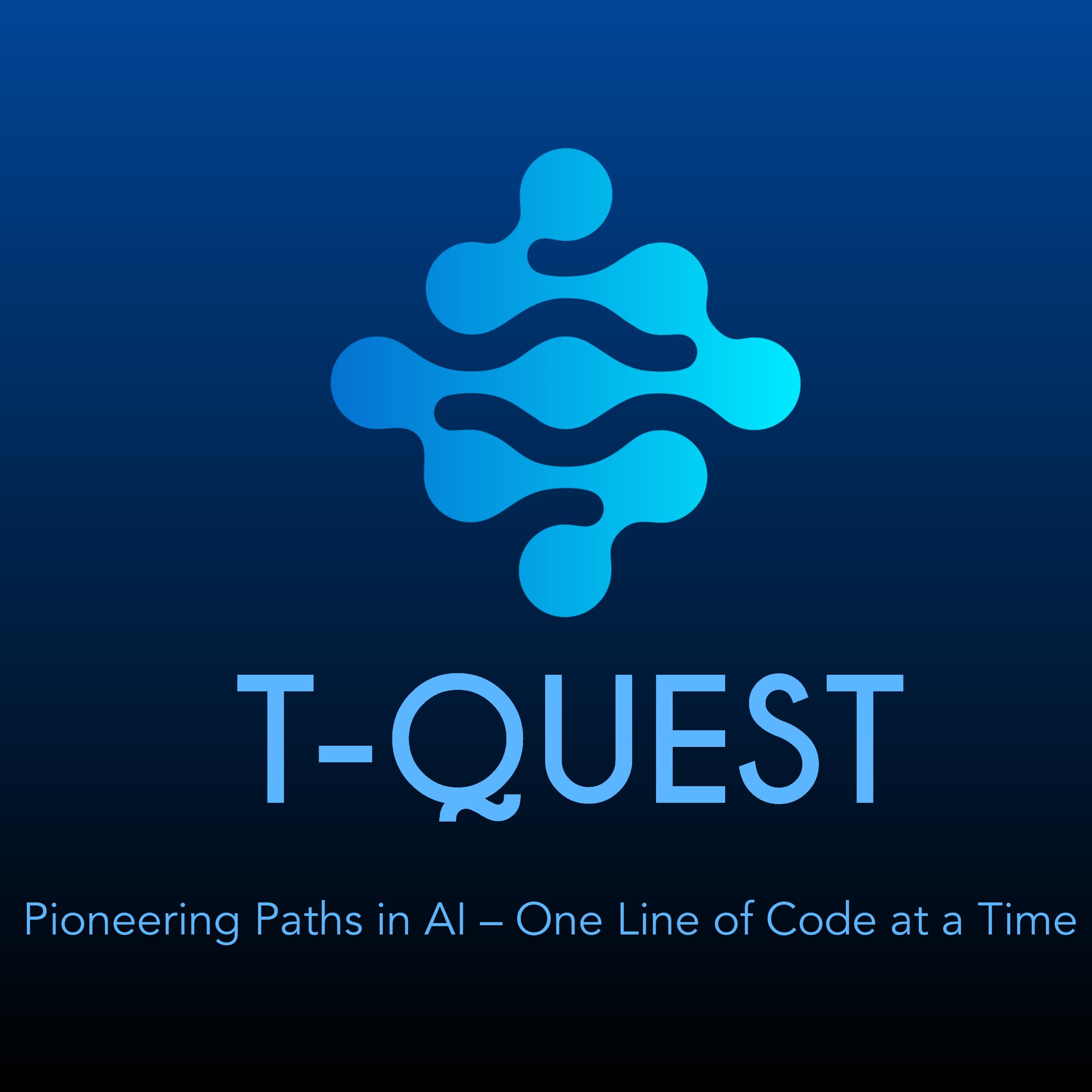
Week Three: 5 - 11 July
In the third week, we learned about responsive design and the two design approaches that can enable us to achieve responsive design. They are the desktop-first and mobile-first design approaches.

The desktop first design approach, as the name suggests involves making the default styling for a webpage/website well suited for a large screen or viewport and using media queries alongside the max-width CSS property to design for small screen sizes.
Essentially, we adjust the default CSS styling for smaller screens using media queries.
The mobile-first design approach is the exact opposite of the desktop-first design approach. Here, the default styling is well suited for the smallest screen size and with the use of media queries and the min-width CSS property, we adjust the CSS styling for larger screens.
During the week, all teams were allocated different projects. Ours was a Medical Prompt System. An AI tool that helps diagnose illnesses based on input symptoms. The required functions of this system were to;
Accept symptom input directly in the terminal.
Provide an option to input multiple symptoms at once.
Integrate AI APIs to enhance diagnosis accuracy and provide more detailed suggestions.
Provide a confidence score for each diagnosis.
Provide basic medical advice or next steps based on the diagnosis (e.g., see a doctor, take rest).
After receiving our allocated project, we conducted a brainstorming session, where we came up with the name SymptomAI, drafted the roadmap for the project, assigned tasks to different group members and decided on using a Chabot UI. I was tasked with the design and responsiveness of the project UI amongst other tasks.
I had the honour of representing the team for our first presentation, it seemed challenging but I was certain that I was equal to the task. The presentation went well and we received feedback from our mentors and moderators.
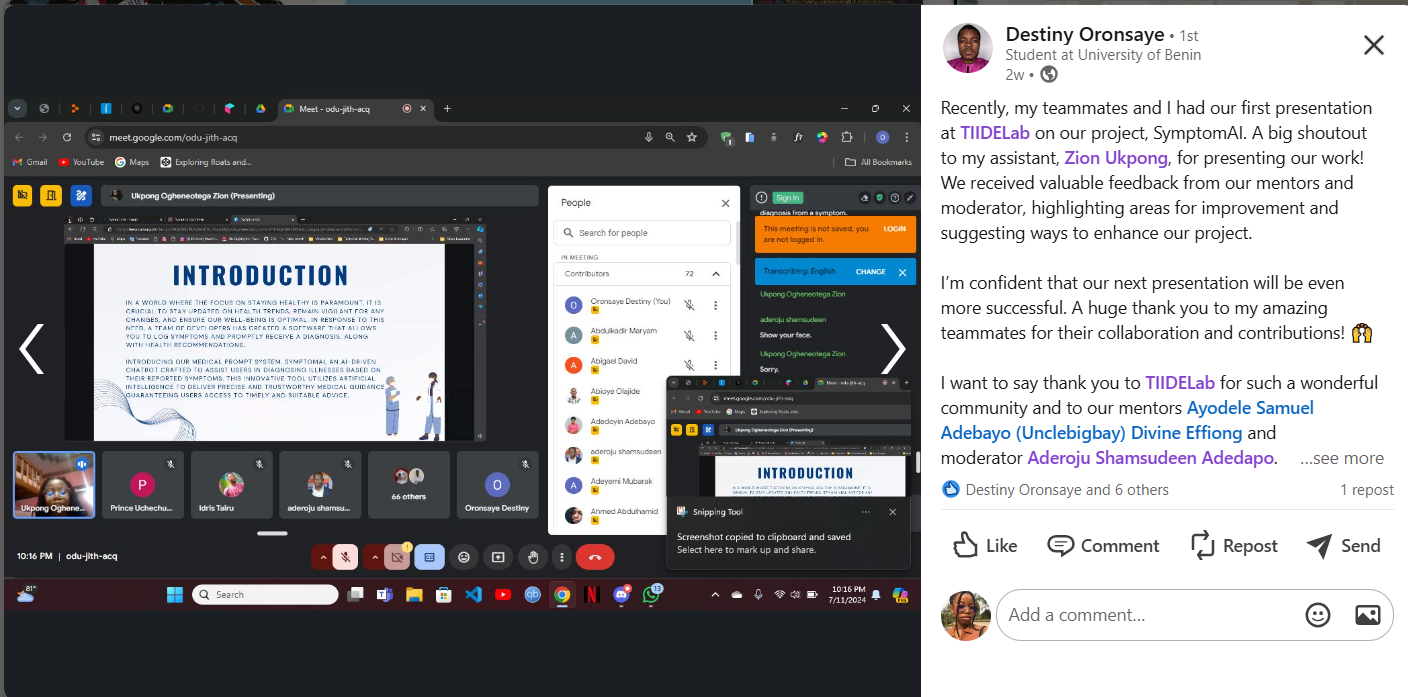
At the end of the third week, we were given our first major assignment: building a portfolio project. It was fun putting everything we've learned into practice😄. Feel free to check out mine↗.
Week Four: 12 - 18 July
At the beginning of the fourth week, some members of the program were evicted due to non-participation. They didn't attend classes, neither did they do the assignments we were given. At TIIDELAB, this is considered unseriousness and so, they were kicked out of the program.
This week came Python. We were taught how to install Python in a way that would allow us to run Python code directly from our command prompt. We were also further introduced to Python basics. This includes data types like integers, strings and boolean, and data structures like lists, tuples and dictionaries, amongst others.
Amidst all these, I was able to finish building the UI for the SymtomAI project, alongside my teammates Oronsaye Destiny, and Oluwaseun Sodeeq in time for the second presentation sprint.
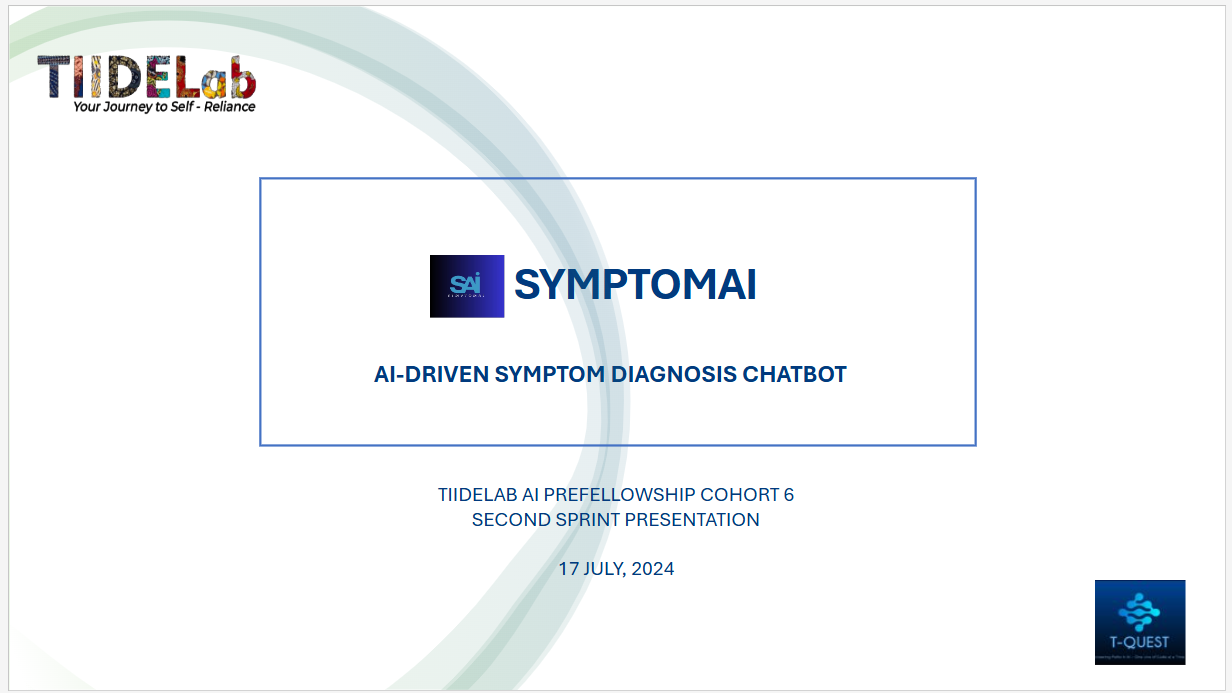
Week Five: 19 - 25 July
In the fifth week, more people got evicted and the rest of us were taught how to create a virtual environment in a directory.
According to the Official Python Docs, a virtual environment is created on top of an existing Python installation, known as the virtual environment’s “base” Python, and may optionally be isolated from the packages in the base environment, so only those explicitly installed in the virtual environment are available.
One of the many usefulness of a virtual environment is that it allows for proper project organization. When a virtual environment is created in a directory, dependencies installed in that directory will not interfere with dependencies in other directories.
Essentially, the scope of all installed packages and dependencies is limited to the virtual environment in which it was created, and as such, the global Python environment remains unaffected.
We also learned how to use APIs. We covered the need for a base URL to call an API and endpoints, which are targets on a web service that can be interacted with to retrieve or manipulate data. Additionally, we learned how to effectively use GET, PUT, POST, and UPDATE requests.
This week we faced a major blocker on the SymptomAI project. After implementing user authentication and data management with Flask, we tried to consume the API given to us by TIIDELAB to complete our project but a lot of formalities needed to be done for us to gain access to the said API. So we had to begin an impromptu search for alternative APIs that could enable us to carry out the objectives of the project. We finally settled on using Gemini API.
The highlight of week five was an info session themed "Building Your AI Skills: Identifying Learning Pathways for AI Enthusiasts." Our guest, the Founder and CEO of XRI Global, Mr Daniel Wilson, spoke at length about language models, what they're building at XRI Global and different ways individuals interested in AI can excel in the field.
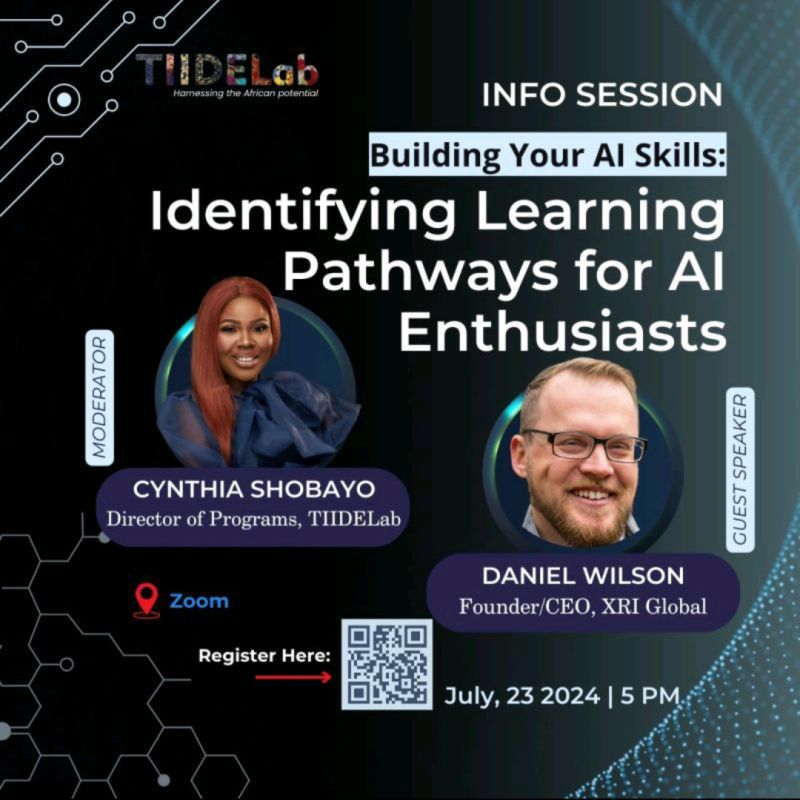
Week Six: 26 July - 2 August
Now, we are in the sixth week, we're drawing the blinds, shutting the doors and bringing the pre-fellowship program to a close.
Of all the weeks, this has to be the most tedious. All classes have been concluded and what's left is the presentation of the product we worked on as a group. The number of group meetings my team, T-Quest, has held from the end of week five till now has tripled! All hands are on deck to make sure the project implementation & presentation goes smoothly and hassle-free.
I'm representing my team and presenting for the final sprint presentation happening today, the 1st of August. I'm confident it will go smoothly. We're well prepared and ready to give our best.
Epilogue
It has been an exciting and challenging journey so far, and I can proudly say that I have developed tact and character. This is a result of the soft skills training sessions held weekly at TIIDELAB, led by the coordinator, Mr Shams. We learned effective communication, presentation skills, and how to be a good team player, among other valuable lessons.
I've also gained basic knowledge in building AI-based Python software during this pre-fellowship program, and I plan to create even more projects as I move forward.
Thank you so much for taking the time to read this far. Until next time dear friends. Au revoir!
Subscribe to my newsletter
Read articles from Zion Ukpong directly inside your inbox. Subscribe to the newsletter, and don't miss out.
Written by

Zion Ukpong
Zion Ukpong
Hi there😊, I'm Zion👋. I like to write, and I like JavaScript. Most of the articles on my blog are centered around JavaScript. I work with HTML, CSS, and, of course, JavaScript. Take a tour of my blog, and see what intrigues you🤭 Welcome✨😊